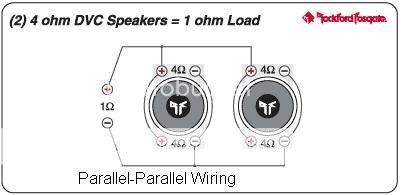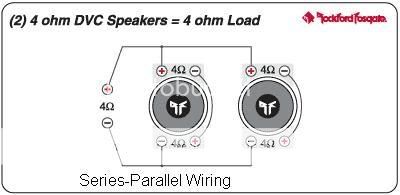Wiring a quad voice coil sub to a 2 channel amp
#2
The amp needs to be bridged. You do not want to wire separate voice coils of a subwoofer to separate channels of an amplifier.
Beyond that, wiring the sub is pretty straightforward, depending on what impedance you are aiming for.
The first thing you need to know is what load the amp will support when bridged. If it will support a 1 ohm mono load, then you can just parallel the coils together. If not, then you can wire two sets of coils in series, then parallel the two series together. Series-Parallel wiring would yield a 4 ohm load.
Parallel-Parallel Wiring

Series-Parallel Wiring

Beyond that, wiring the sub is pretty straightforward, depending on what impedance you are aiming for.
The first thing you need to know is what load the amp will support when bridged. If it will support a 1 ohm mono load, then you can just parallel the coils together. If not, then you can wire two sets of coils in series, then parallel the two series together. Series-Parallel wiring would yield a 4 ohm load.
Parallel-Parallel Wiring

Series-Parallel Wiring

#3
Ya the sub is a MA audio ma1200xl and i tried it like the series-parralel and it works but would a diff way sound better? And its gonna be hooked up to a 1200 watt xplod 2-channel amp. Not the best for the sub but its all i have right
now. ha ha
now. ha ha
#4
Originally Posted by Clean_XB
Originally Posted by UV7
The amp needs to be bridged. You do not want to wire separate voice coils of a subwoofer to separate channels of an amplifier.
Beyond that, wiring the sub is pretty straightforward, depending on what impedance you are aiming for.
The first thing you need to know is what load the amp will support when bridged. If it will support a 1 ohm mono load, then you can just parallel the coils together. If not, then you can wire two sets of coils in series, then parallel the two series together. Series-Parallel wiring would yield a 4 ohm load.
Parallel-Parallel Wiring

Series-Parallel Wiring

Beyond that, wiring the sub is pretty straightforward, depending on what impedance you are aiming for.
The first thing you need to know is what load the amp will support when bridged. If it will support a 1 ohm mono load, then you can just parallel the coils together. If not, then you can wire two sets of coils in series, then parallel the two series together. Series-Parallel wiring would yield a 4 ohm load.
Parallel-Parallel Wiring

Series-Parallel Wiring

Might I ask what woofer is this?
I would say that you should either bridge a 4 channel amp using 2 sets of coils per bridged channel, or find a mono block subwoofer that has an extremely low load ohm for flexibility....like A hifonics or something of that nature
Wiring a quad coil can be tricky, check this out:
http://forum.ecoustics.com/bbs/messages/4/189064.html
This is why I used the diagram above.
You do NOT want to wire these coils separately, whether it is in pairs or individually. You absolutely WILL destroy the woofer! The coils on multi-coil drivers, including the QVC woofer posted, do not move independently. They are intended to allow for multiple wiring options, which can drop the impedance, thereby increasing the power output of the amplifier, but their physical movement is no different than that of a single-coil woofer. Wiring them to separate channels runs serious risk of significant enough variance in signal to cause the coils to fight, or pull in opposite directions, which will damage the woofer VERY quickly.
The MA1200XL QVC has 4 4-ohm coils. 4 coils wired in parallel-parallel will yield a 1 ohm load. This load is, by no means, difficult for today's Class D amplifiers and certainly will NOT require a huge amplifier as the multiple posts from the link above suggest. Most manufacturers offer dual 2-ohm coil woofers, which, when wired in parallel, will yield the same load. 2-ohm DVC setups are EXTREMELY common and haven't posed any difficulties that I've ever experienced.
At the present time, your best bet would be to continue using the 1200w Xplod wired in series parallel until you find a good Class D mono amplifier that will dish out 600-1000w RMS @ 1 ohm. Class D amps are relatively cheap, so this one will not cost you tons of $$$.
Good luck! I hope this info helps you out.
#6
Hi...when you bridge an amp, the amp reads half the ohms. Thats why 2-channel amps that are 2 ohm stable can only be bridged at 4-ohms, cuz the amp actually sees 2 ohms. Get it? That's why he has to have a .5 ohm stable amp either way.
circuit board assembly services
circuit board assembly services
Last edited by LilasCook; 02-26-2021 at 10:57 PM.
Thread
Thread Starter
Forum
Replies
Last Post









